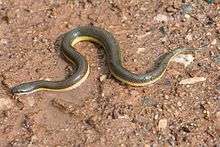Rice paddy snake
| Rice paddy snake | |
|---|---|
 | |
| Enhydris plumbea from Phetchabun Provonce, West Thailand | |
| Scientific classification | |
| Kingdom: | Animalia |
| Phylum: | Chordata |
| Class: | Reptilia |
| Order: | Squamata |
| Suborder: | Serpentes |
| Family: | Homalopsidae |
| Genus: | Hypsiscopus |
| Species: | H. plumbea |
| Binomial name | |
| Hypsiscopus plumbea (F. Boie, 1827) | |
| Synonyms[2] | |
| |
The rice paddy snake (Hypsiscopus plumbea) is a species of mildly venomous, rear-fanged, colubrid snake endemic to South Asia.
Geographic range
H. plumbea is found in India, Burma, Cambodia, Indonesia, Laos, Malaysia, southeastern China, Thailand, and Vietnam.
Habitat
The rice paddy snake is a common and abundant species associated with all sorts of wet habitats.
Taxonomy
DNA evidence suggests that this taxon might be a species complex.[1]
Description
The rice paddy snake is a relatively small snake, reaching a total length (including tail) of up to 72 cm (28 in).[3]

 Enhydris plumbea
Enhydris plumbea
from Karawang, West Java
References
- 1 2 Murphy, J. (2010). "Enhydris plumbea". The IUCN Red List of Threatened Species. IUCN. 2010: e.T176699A7285894. doi:10.2305/IUCN.UK.2010-4.RLTS.T176699A7285894.en. Retrieved 15 January 2018.
- ↑ "Hypsiscopus plumbea ". The Reptile Database. www.reptile-database.org.
- ↑ Breuer, Hans; William Christopher Murphy (2009–2010). "Enhydris plumbea". Snakes of Taiwan. Retrieved 13 October 2012. External link in
|work=(help)
Further reading
- Boie, F. (1827). "Bemerkungen über Merrem's Versuch eines Systems der Amphibien, 1. Lieferung: Ophidier ". Isis van Oken [Jena] 20: 508-566. (Homalopsis plumbea, new species, p. 550).
- Boulenger, G.A. (1896). Catalogue of the Snakes in the British Museum (Natural History). Volume III., Containing the Colubridæ (Opisthoglyphæ and Proteroglyphæ), ... London: Trustees of the British Museum (Natural History). (Taylor and Francis, printers). xiv + 727 pp. + Plates I-XXV. (Hypsirhina plumbea, pp. 5–6).
- Das, Indraneil. (2006). A Photographic Guide to Snakes and Other Reptiles of Borneo. Sanibel Island, Florida: Ralph Curtis Books. 144 pp. ISBN 0-88359-061-1. (Enhydris plumbea, p. 34).
- Ghodke, Sameer; Harry V. Andrews. (2002). Enhydris plumbea (Boie, 1827) (Serpentes: Colubridae: Homalopsinae), a new record for India. Hamadryad 26 (2): 373-375. [2001]
- Gray, J.E. (1842). Monographic Synopsis of the Water Snakes, or the Family Hydridae. Zoological Miscellany 1842: 59-68. (Hypsirhina plumbea, p. 66).
- Smith, M.A. (1943). The Fauna of British India, Ceylon and Burma, Including the Whole of the Indo-Chinese Sub-region. Reptilia and Amphibia. Vol. III.—Serpentes. London: Secretary of State for India. (Taylor and Francis, printers). xii + 583 pp. (Enhydris plumbea, pp. 382–383, Figure 122).
- Stejneger, Leonard. (1907). Herpetology of Japan and Adjacent Territory. United States National Museum Bulletin 58. Washington, District of Columbia: Smithsonian Institution. xx + 577 pp. (Enhydris plumbea, pp. 300–302, Figures 260-262).
- Voris, Harold K.; Karns, Daryl R. (1996). Habitat utilization, movements, and activity patterns of Enhydris plumbea (Serpentes: Homalopsinae) in a rice paddy wetland in Borneo. Herpetological Natural History 4 (2): 111-126.
This article is issued from
Wikipedia.
The text is licensed under Creative Commons - Attribution - Sharealike.
Additional terms may apply for the media files.
